You know how everyone loves a steaming bowl of Sinigang? While pork is the traditional go-to, I actually prefer making mine with chicken, especially on busy weeknights when I want something lighter but just as comforting.
This chicken sinigang version has become my family's favorite. It's quicker to cook, easier on the budget, and honestly, it lets the sour tamarind broth shine through more clearly. Plus, when I'm trying to eat a bit healthier but still craving that signature Filipino sourness, this is my perfect solution.
I've been making this variation ever since my mother-in-law showed me how, and trust me, once you try this lighter take on our beloved Sinigang, you might find yourself reaching for chicken more often than pork. All the vegetables work just as beautifully with chicken, and you still get that same soul-warming feeling that makes Sinigang such a treasured dish in every Filipino home.
What is Sinigang na Manok?
Sinigang na Manok is a cornerstone of Filipino cuisine - a chicken soup distinguished by its bright, sour tamarind broth. This dish combines tender chicken pieces with an assortment of fresh vegetables like daikon radish, eggplant, okra and water spinach, all simmered together until the meat is succulent and the vegetables are just-tender.
The defining sourness comes traditionally from tamarind, though modern versions often use a convenient powder mix that delivers the signature tang. While less common than its pork counterpart, this lighter chicken version offers the same soul-warming comfort with a cleaner finish that lets the interplay between the tart broth, savory chicken, and garden-fresh vegetables shine through.
Jump to:
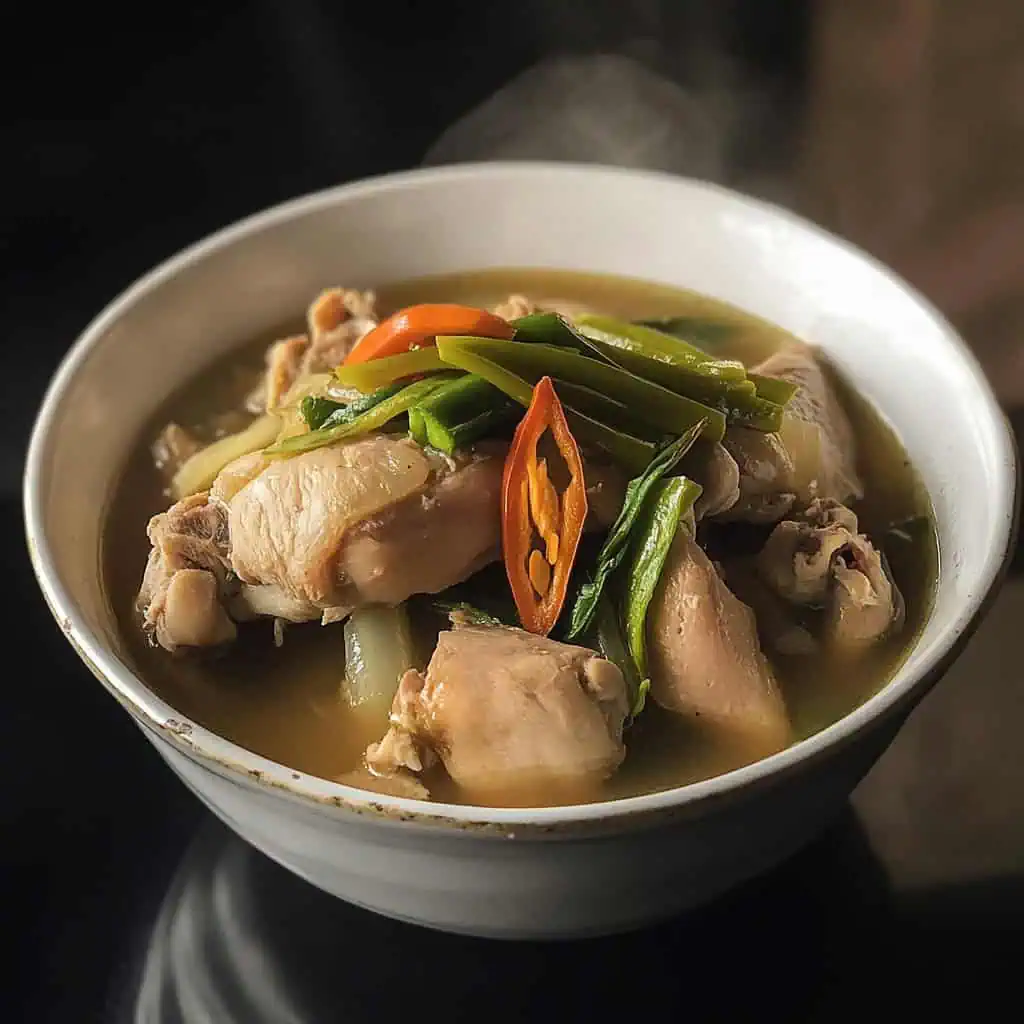
Why You'll Love This Recipe
- Perfect balance of sour and savory flavors
- One-pot comfort meal ideal for rainy days
- Packed with nutritious vegetables
- Easy to customize with available ingredients
- Ready in under an hour
- Budget-friendly family meal
Ingredients
Each ingredient in this Sinigang na Manok serves a specific purpose, creating the perfect balance of flavors and textures. Bone-in chicken pieces provide rich flavor while absorbing the tangy broth.
The tamarind soup base delivers that signature sour note that defines sinigang. Vegetables like daikon add sweetness, eggplant absorbs the broth's flavor, okra provides thickening, and leafy greens offer freshness and nutrition. Tomatoes and onions create a savory base, while fish sauce adds the umami element that brings everything together.
This thoughtful combination results in a harmonious soup where each component enhances the others.
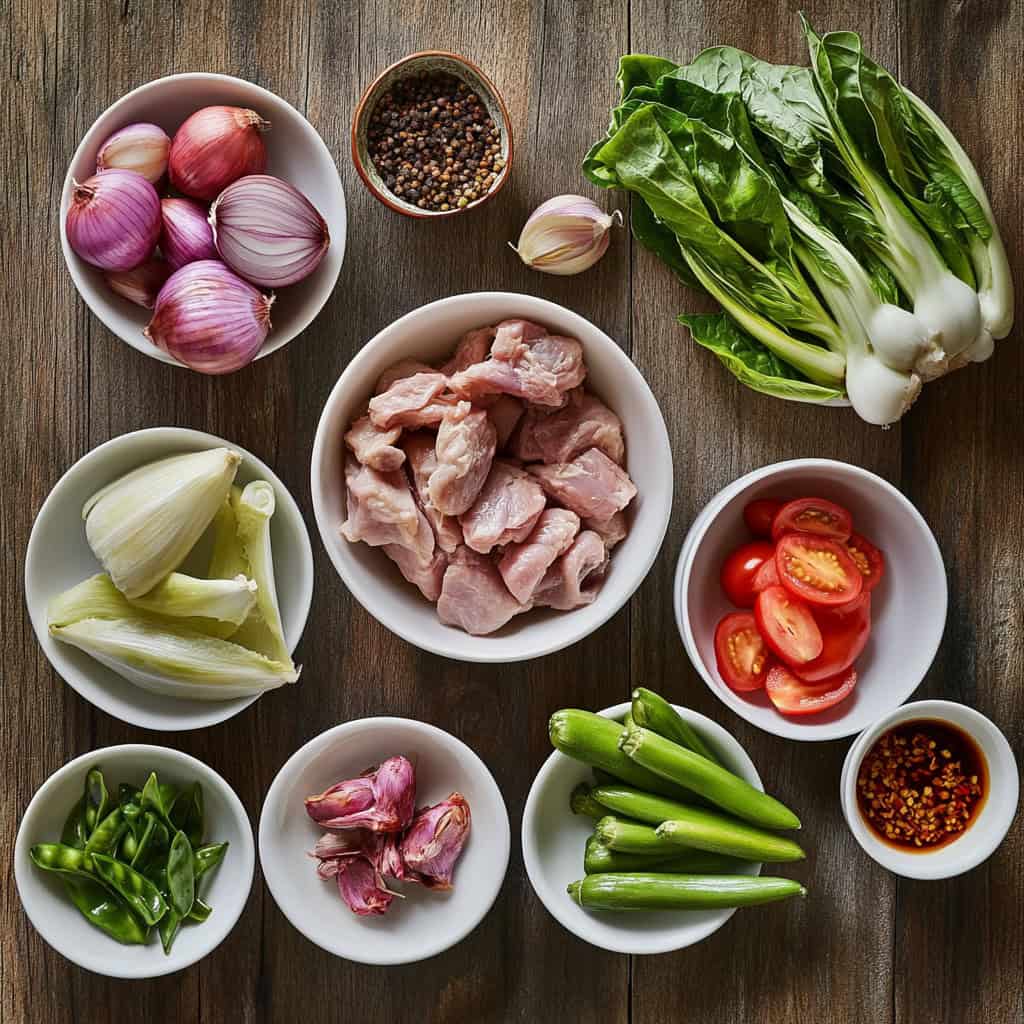
For the Broth:
- 1½ lbs chicken pieces, preferably with bone
- 2 tablespoons cooking oil
- 8 cups water
- 1 packet (40g) tamarind soup base (sinigang mix)
- 2-3 tablespoons fish sauce
- 1 chicken bouillon cube (optional)
Vegetables:
- 1 large tomato, quartered
- 1 medium red onion, quartered
- 4-inch daikon radish, sliced diagonally
- 1 small eggplant, sliced diagonally
- 4 pieces okra, ends trimmed
- 2 cups water spinach, stems and leaves separated
- 5 leaves bok choy
- 2 pieces long green chilies (optional)
Equipment
- Large Heavy-Bottom Pot (Kaldero) - Provides even heat distribution for consistent cooking of the soup
- Sharp Knife - For precisely cutting vegetables and chicken pieces
- Wooden Spoon - Prevents scratching the pot while stirring and helps distribute ingredients evenly
- Spider Strainer - Essential for skimming off any impurities that rise to the surface while cooking
- Ladle - For serving the finished soup into individual bowls
- Measuring Cups and Spoons - Ensures precise ingredient portions for balanced flavor
- Cutting Board - Provides a clean, stable surface for all prep work
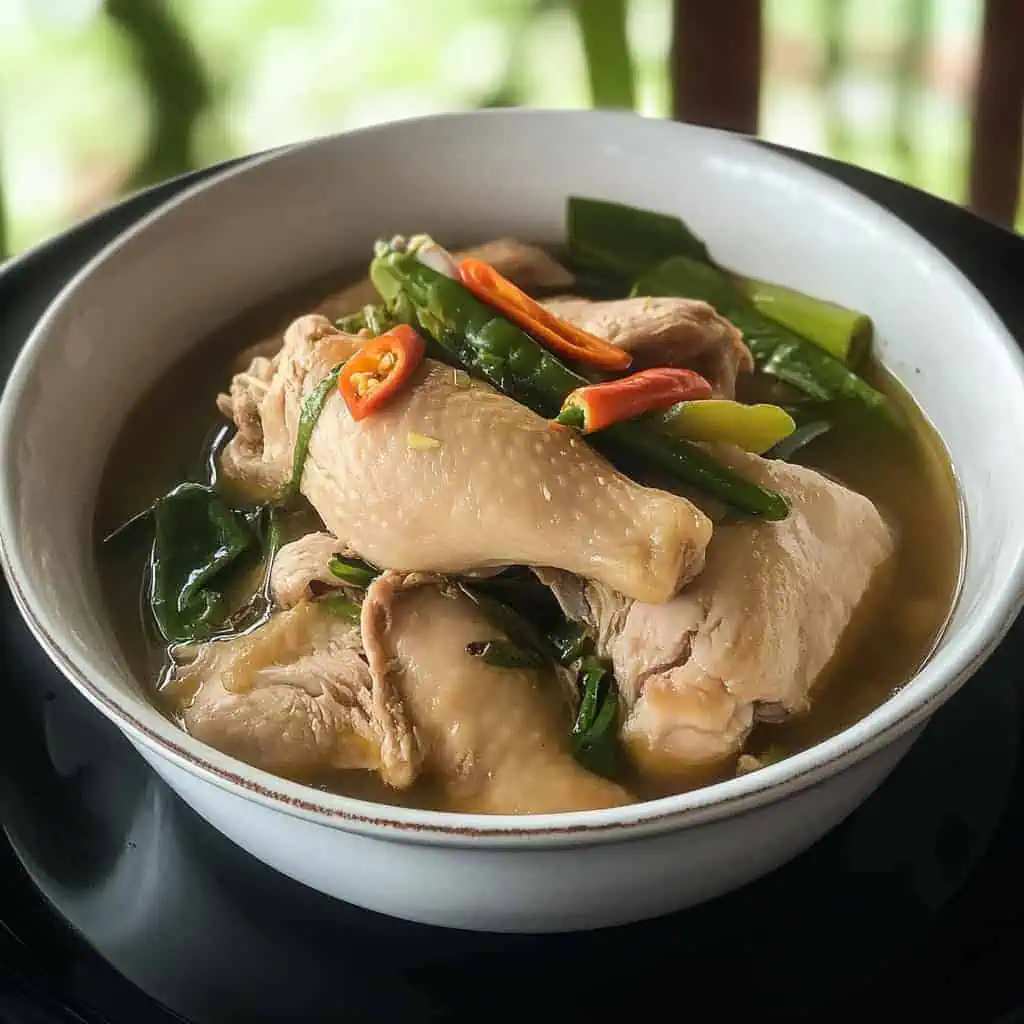
How To Make
- Heat cooking oil in a large pot over medium heat. Season the chicken pieces with salt and pepper, then brown them in the hot oil for about 5 minutes on each side until golden. Remove the chicken and set aside.
- Using the same pot with the chicken drippings, add the tomatoes and onions. Let them cook until the tomatoes start to break down and the onions become soft, about 3-4 minutes.
- Pour in 8 cups of water and add the chicken bouillon cube. Bring to a boil, then reduce heat to medium. Add the tamarind soup base, stirring until it completely dissolves. Return the browned chicken to the pot and add 2 tablespoons of fish sauce. Let this simmer for 10 minutes.
- Add the sliced daikon radish to the pot. Cover and cook for 8 minutes until the radish starts to soften.
- Add the eggplant and okra to the pot. Continue cooking for 5 minutes or until these vegetables are just tender.
- When the eggplant and okra are almost done, add the water spinach stems if using. Cook for 2 minutes, then add the leaves and bok choy. Cook just until the greens wilt, about 1-2 minutes.
- Taste the broth and adjust the seasoning with more fish sauce or tamarind mix if needed. Your soup should be clearly sour and savory.
- Turn off the heat and let the soup rest for 2-3 minutes before serving. This helps the flavors settle and prevents the vegetables from overcooking.
- Serve hot in bowls, with steamed rice on the side. Provide extra fish sauce and chopped chilies at the table so everyone can adjust the taste to their liking.

Tips from Lola's Kitchen
- Use bone-in chicken parts for a much richer, more flavorful broth. The bones release collagen and minerals that give the soup depth.
- Add tamarind mix gradually until you reach your preferred level of sourness. You can always add more, but you can't take it away!
- Never cover the pot when cooking leafy vegetables - this preserves their vibrant green color and prevents them from becoming mushy.
- Skim off any foam that rises to the top during cooking for a clearer, more attractive broth.
- Cook vegetables in stages based on their hardness. Start with the firmest vegetables and end with the leafiest ones for perfect doneness across all ingredients.
- Brown the chicken well before making the broth - those caramelized bits add incredible flavor to the final soup.
- Let the soup rest for a few minutes before serving to let the flavors harmonize and develop.
Substitutions
- Tamarind Mix: Use 2-3 tablespoons of fresh tamarind paste, kamias (bilimbi), or even green mango pulp for an authentic sour flavor
- Chicken: Turkey works well as an alternative, or try a seafood version with fish or shrimp for a different twist
- Fish Sauce: If unavailable, substitute with sea salt or soy sauce (though the flavor profile will change slightly)
- Bok Choy: Regular spinach, mustard greens, or napa cabbage can be used instead
- Daikon Radish: White radish or turnip provides a similar crunchy texture
- Water Spinach: Morning glory or regular spinach make excellent alternatives
- Okra: Green beans or wing beans can replace okra for a different texture
Troubleshooting
- Broth too sour? Add more water or an extra chicken bouillon cube to balance the flavors. A small pinch of sugar can also help counteract excessive sourness.
- Vegetables too soft? Remember to add vegetables in the correct order, with the most delicate ones going in last. For very tender vegetables like leafy greens, add them only in the final 1-2 minutes of cooking.
- Chicken not tender enough? Extend the simmering time before adding the vegetables. For particularly tough chicken, you may need an extra 10-15 minutes of gentle simmering.
- Broth too thin? Allow the soup to simmer uncovered for 5-10 minutes to reduce and concentrate the flavors before adding the vegetables.
- Not sour enough? Add more tamarind mix or a squeeze of calamansi/lime juice just before serving for a fresh burst of acidity.
Storage & Reheating
Refrigeration:
- Store in an airtight container for up to 3 days
- Separate vegetables from broth if storing longer than 1 day to prevent them from becoming soggy
- Cool completely before refrigerating to prevent bacterial growth
- Store rice separately to prevent it from absorbing too much broth and becoming mushy
Freezing:
- Freezer-safe for up to 2 months
- Freeze broth and chicken separately from vegetables for best texture
- Not recommended to freeze leafy vegetables as they become mushy when thawed
- Label with date and contents to keep track of storage time
Reheating:
Stovetop (Best Method):
- Heat over medium heat until gently simmering (165°F/74°C)
- Add fresh vegetables if desired to replace any that became soggy during storage
- Avoid rapid boiling to prevent chicken from toughening
- Adjust seasoning before serving, as flavors may have intensified during storage
Microwave (Quick Method):
- Heat in 1-minute intervals, stirring between each interval to ensure even heating
- Cover with a microwave-safe lid or damp paper towel to retain moisture
- Let stand for 1 minute before serving to allow the heat to distribute evenly
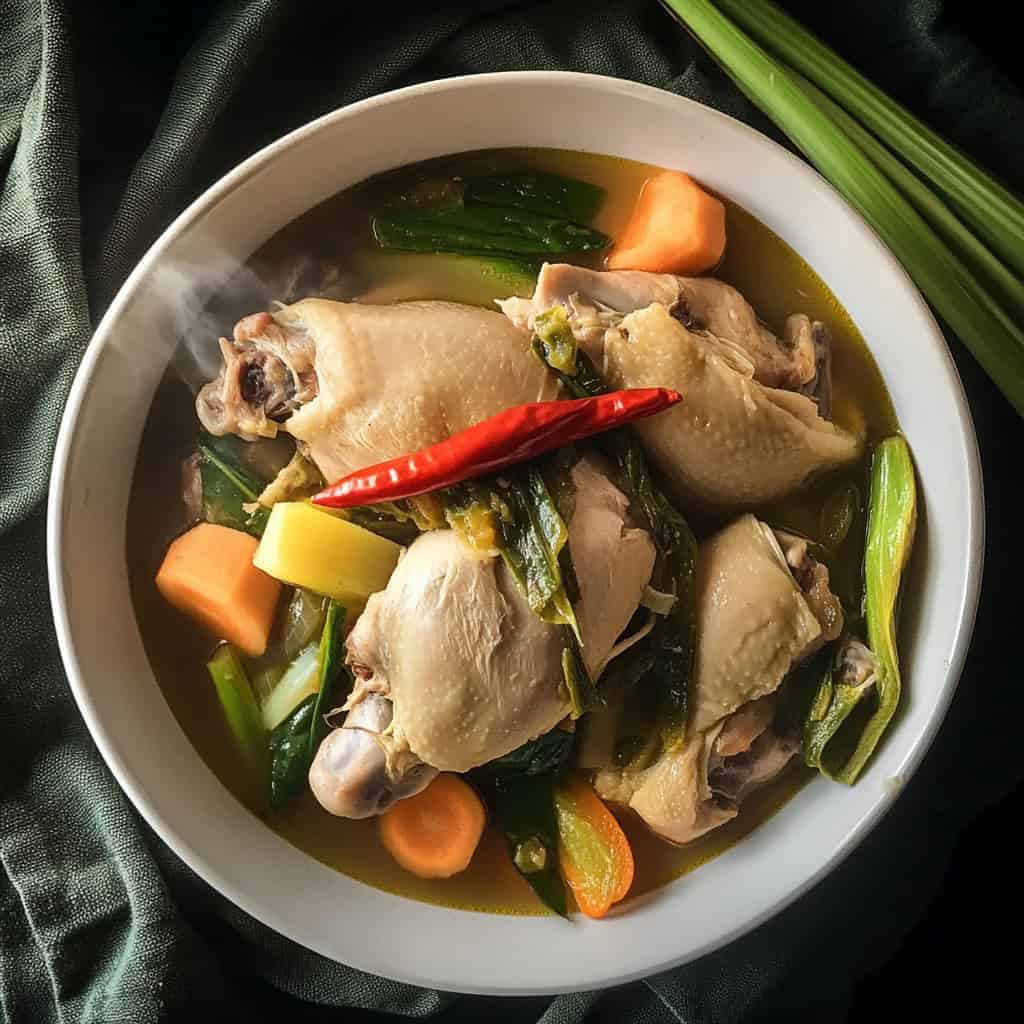
FAQ
Why isn't my broth sour enough?
Add tamarind mix gradually, tasting as you go. Different brands vary in intensity. You can always add more fish sauce or a squeeze of calamansi or lime juice just before serving for extra flavor.
Can I use chicken breast instead of bone-in pieces?
Yes, but reduce cooking time to 20-25 minutes to prevent the meat from drying out. Also, consider adding an extra bouillon cube to compensate for the lack of bone-derived flavor.
Why did my vegetables become mushy?
Add vegetables in stages based on cooking time - hard vegetables first, leafy ones last. Remember that vegetables continue cooking from residual heat even after the stove is turned off.
Is this recipe keto-friendly?
Modify by omitting starchy vegetables like radish and increasing low-carb options like bok choy, spinach, and mushrooms. Keep the chicken and broth the same for authentic flavor.
Can I make this in advance for a party?
Yes, prepare the broth and chicken a day ahead, then reheat and add fresh vegetables just before serving. This actually improves the flavor as the broth has time to develop.
How do I make this soup less spicy for children?
Simply omit the chilies entirely and serve them on the side for adults. The sour-savory flavor is usually appealing to children even without the heat.
Can I use a slow cooker for this recipe?
Yes! Brown the chicken first, then combine all ingredients except the leafy vegetables in a slow cooker. Cook on low for 6-8 hours or high for 3-4 hours, adding the leafy greens in the last 10 minutes.
What makes the authentic sour flavor in traditional sinigang?
Traditionally, fresh tamarind (sampalok) provides the signature sourness. Today, many home cooks use convenient tamarind soup mix packets, which contain dehydrated tamarind and other seasonings.
Related
Looking for other recipes like this? Try these:

Authentic Sinigang na Manok (Filipino Sour Chicken Soup)
Equipment
- Large Heavy-Bottom Pot (Kaldero) for even heat distribution
- Sharp knife (kutsilyo) for preparing vegetables
- Wooden spoon (sandok na kahoy) prevents scratching the pot
- Spider strainer (siyanse) for skimming impurities
- Ladle - sandok for serving
- Measuring cups and spoons (Panukat) for precise ingredients portions
- Cutting board (Sangkalan) for prep work
Ingredients
For the Broth
- 1½ lbs chicken pieces manok, preferably with bone
- 2 tablespoons cooking oil
- 8 cups water
- 1 packet 40g tamarind soup base (sinigang mix)
- 2-3 tablespoons fish sauce patis
- 1 chicken bouillon cube optional
Vegetables
- 1 large tomato kamatis, quartered
- 1 medium red onion sibuyas, quartered
- 4- inch daikon radish labanos, sliced diagonally
- 1 small eggplant talong, sliced diagonally
- 4 pieces okra okra, ends trimmed
- 2 cups water spinach kangkong, stems and leaves separated
- 5 leaves bok choy pechay
- 2 pieces long green chilies siling haba - optional
Instructions
- Heat cooking oil in a large pot over medium heat. Season the chicken pieces with salt and pepper, then brown them in the hot oil for about 5 minutes on each side until golden. Remove the chicken and set aside.
- Using the same pot with the chicken drippings, add the tomatoes and onions. Let them cook until the tomatoes start to break down and the onions become soft, about 3-4 minutes.
- Pour in 8 cups of water and add the chicken bouillon cube. Bring to a boil, then reduce heat to medium. Add the tamarind soup base, stirring until it completely dissolves. Return the browned chicken to the pot and add 2 tablespoons of fish sauce. Let this simmer for 10 minutes.
- Add the sliced daikon radish to the pot. Cover and cook for 8 minutes until the radish starts to soften.
- Add the eggplant and okra to the pot. Continue cooking for 5 minutes or until these vegetables are just tender.
- When the eggplant and okra are almost done, add the water spinach stems if using. Cook for 2 minutes, then add the leaves and bok choy. Cook just until the greens wilt, about 1-2 minutes.
- Taste the broth and adjust the seasoning with more fish sauce or tamarind mix if needed. Your soup should be clearly sour and savory.
- Turn off the heat and let the soup rest for 2-3 minutes before serving. This helps the flavors settle and prevents the vegetables from overcooking.
- Serve hot in bowls, with steamed rice on the side. Provide extra fish sauce and chopped chilies at the table so everyone can adjust the taste to their liking.
- Making sinigang is all about timing the vegetables - add them in order of how long they take to cook, starting with the hardest vegetables first. This way, everything will be perfectly cooked when you're ready to serve.
Tips from Lola's Kitchen
- Use chicken parts with bones for richer broth
- Add tamarind mix gradually to control sourness
- Never cover the pot when cooking leafy vegetables
- Skim off foam for clearer broth
- Let vegetables cook in order of hardness
Nutrition
The Story Behind Filipino Sinigang na Manok
Growing up in a Filipino household, Sinigang has always been our go-to comfort food, but it wasn't until I started cooking for my own family that I discovered the lighter, equally delicious chicken version of this beloved soup. While pork Sinigang might be more commonly known, Sinigang na Manok carries its own rich history in Philippine cuisine, especially in regions where chicken was more readily available than pork.
The origins of Sinigang itself date back centuries in Philippine culinary history, with each region developing its own unique take on this sour soup. The dish showcases the Filipino mastery of combining sour flavors (asim) with savory elements, a cooking technique that's deeply embedded in our cultural identity. Historically, our ancestors used native tamarind (sampalok) to create the signature sourness, a practice that continues in many traditional households today.
Sinigang na Manok emerged as a practical adaptation of the classic recipe. In many Philippine provinces, especially in rural areas where chickens were raised in backyards, this version became a staple. The dish perfectly demonstrates the Filipino tradition of adaptability in cooking – using available ingredients while maintaining the essential character of the dish. This chicken version is particularly popular during the rainy season, when Filipinos seek out hot, comforting soups that are lighter than their pork counterparts.
What makes this version special is how the delicate flavor of chicken allows the sour tamarind broth to take center stage. The meat absorbs the tangy soup beautifully, while still maintaining its own subtle flavors. It's a perfect example of how Filipino cuisine continues to evolve while honoring its roots – adapting traditional recipes to modern lifestyles and dietary preferences without losing their cultural essence.
In many Filipino homes today, Sinigang na Manok represents not just a meal, but a connection to our culinary heritage. Whether made with traditional sampalok or convenient modern soup bases, each bowl carries the warmth of generations of Filipino home cooking. This recipe I'm sharing with you today combines time-honored techniques with practical modern adaptations, making it accessible for anyone craving this classic Filipino comfort food.
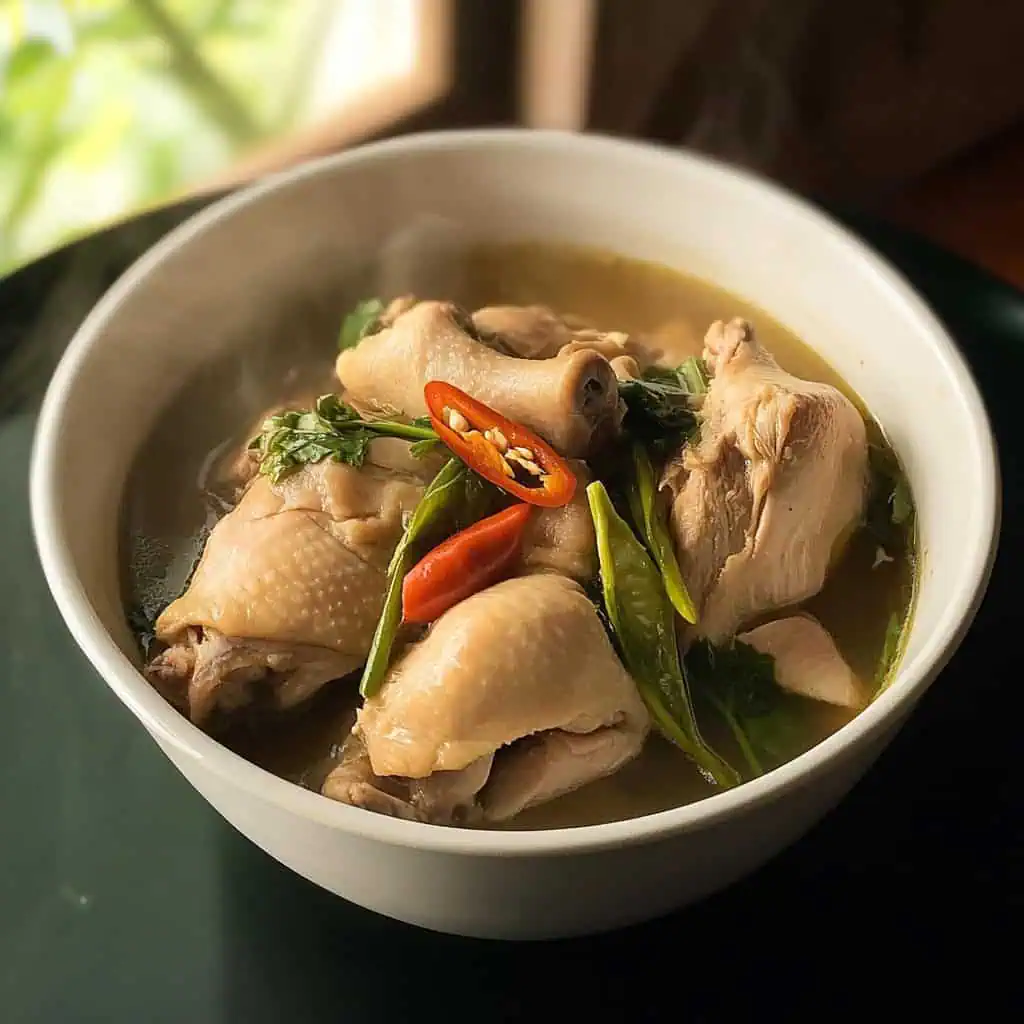









Comments
No Comments